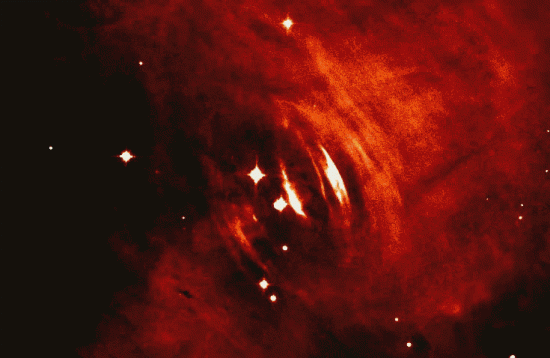
May 20, 2019
The Crab is 25 kilometers wide, with a mass of 1.5 times that of the Sun, and is said to rotate at 30 times per second.
Previous Pictures of the Day discuss the problems associated with neutron stars. The most important contradiction in the theory is that they violate the “island of stability” in nuclear physics. Neutrons plotted against the number of protons reveals a ratio of about one-to-one for light nuclei and one point five-to-one for heavier nuclei. Anything outside that range decays until it reaches equilibrium. Too many neutrons means that atoms will acquire protons until they stabilize, or vise-versa. Therefore, an atomic nucleus consisting of neutrons, alone, would immediately decay.
However, consensus astrophysicists believe that neutron stars account for anomalous pulsar behavior, such as brightness fluctuations over a short time. An example of that phenomenon is the Crab Nebula pulsar. Pulsars are thought to be the leftovers after stars “blow off” their outer layers in powerful explosions, leaving a super-dense core behind. Electrons in the stellar core are said to be compressed until they combine with protons in the nuclei, forming matter so dense that a single teaspoon would weigh billions of tons on Earth.
It requires a neutron star’s magnetic field to exceed 10^15 Gauss in order to form a neutron star, although, it should be noted, the evidence for neutron stars is indirect and none have ever been observed. Intense magnetic fields pulsing in fractions of a second are what astronomers interpret as neutron star activity.
NASA launched the Fermi Gamma Ray Space Telescope on June 11, 2008. Since gamma rays are unable to penetrate Earth’s atmosphere, Fermi was placed in high orbit. Scientists from the University of California Santa Cruz Institute for Particle Physics used Fermi to mark 16 new pulsars from scans of their gamma ray emissions.
Pulsars are described as “lighthouses,” with concentrated energy constricted to narrow beams from the rapidly spinning neutron star. When a pulsar’s beam comes in line with Earth, a flash of light can be seen.
A major conundrum for astronomers is the rotation rates of some pulsars: faster than one revolution per second. Nothing known to science can withstand those physical forces, so neutron stars were invented. Only something that dense was thought able to withstand such rotational velocity. The Crab Nebula is emitting such extremely energetic gamma ray bursts that one astrophysicist wrote:
“We thought we knew the essential ingredients of the Crab Nebula but that’s no longer true. It’s still surprising us…We were dumbfounded.”
Since gamma ray flares in the Crab occur in as little as two days before the intensity drops back to normal levels, the research team acknowledges that the rapid slew rate points to synchrotron radiation as the gamma ray source: ten trillion electron volts worth.
The Crab Nebula pulses at 30 times per second, so by definition, the central star rotates 30 times per second. As mentioned, Electric Star theory proposes that neutron stars are imaginary objects. A gravity-only cosmology requires them because the forces generated from spinning billions of megatons as fast as a power drill would cause the star to tear itself apart.
Since magnetic fields are induced by electric currents, there must be electricity generating the intense fields in a pulsar. Those “feeder currents” must also be part of a circuit, since persistent electric current must flow in a completed circuit. Electric Universe advocates speculate that the oscillations in pulsars are caused by resonant effects in those circuits. The sudden release of stored electrical energy in a “double layer” is responsible for their energetic outbursts.
Stephen Smith












